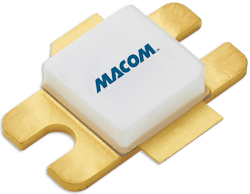Decoding Discrete Power Transistors
This file type includes high resolution graphics and schematics when applicable.
Discrete power transistors for RF/microwave applications have not yet been driven into obsolescence by monolithic devices. They still have their places, especially in applications where higher power densities are required, as in communications transmitters and pulsed radar systems. A number of technologies on different substrate materials form the building blocks for high-frequency discrete power transistors, covering a wide range of frequencies and power levels for both continuous-wave (CW) and pulsed applications.
Power transistors are built from a variety of substrate materials, with lower-frequency devices still fabricated from silicon (Si), while higher-frequency transistors are formed from gallium arsenide (GaAs) and gallium nitride (GaN) substrates. Despite their higher cost, GaN materials have grown in popularity for both discrete transistors and integrated circuits (ICs) because of their excellent high-power, high-frequency characteristics—which enable much greater power densities than GaAs at equivalent frequencies.
Whether in CW or pulsed applications, generating high power levels from a relatively small device is always a concern for the large amounts of heat that must be dissipated within a small area. As critical as the substrate materials are to discrete transistor performance, the packaging materials also play key roles in device performance and reliability. Many discrete power transistor suppliers offer devices in packages or as unpackaged die. Discrete transistor packages have traditionally been composed of thermally conductive materials, such as metals and ceramic materials. In recent years, device designers have developed plastic composite materials that provide effective long-term thermal dissipation of device heat at lower cost than metal/ceramic packaging.
Several device technologies are commonly used for RF/microwave applications. For high-power amplification below about 2 GHz, silicon bipolar transistors or silicon metal-oxide-semiconductor field-effect transistors (MOSFETs) are capable of high levels of CW and pulsed output power. As an example of the former transistor type, model MAPR-001214-380M00 from MACOM Technology Solutions is a negative-positive-negative (NPN) silicon bipolar power transistor capable of 380 W pulsed output power from 1200 to 1400 MHz. Operating under Class C bias conditions with 150- μs pulses at 10% duty cycle, the discrete bipolar transistor is typically employed in avionics radar systems. The small device achieves 8.8 dB minimum power gain across the full bandwidth with 45% collector efficiency. The typical output power for a 50-W input signal is 458 W output power at 1200 MHz and 421 W output power at 1400 MHz. The firm also produces numerous high-power silicon MOSFET discrete transistors, such as the MRF176GV which is usable to 500 MHz. It provides 200 W CW output power at 225 MHz with 17-dB typical gain and 55% typical efficiency.
Packaging Is Critical
The importance of packaging for such high-power devices cannot be overstated, given the extremely high power density of the transistor. Even with its relatively high efficiency, a great deal of the energy supplied to the transistor ends up as heat that must be dissipated. The device features gold metallization and a robust RoHS-compatible metal/ceramic flange-mount package that is hermetically sealed for environmental protection (see figure). Packaging for discrete power transistors is typically a function of output power, with the transistors at higher power levels requiring lager ceramic/metal housings while lower-power devices can often be accommodated in drop-in or even surface-mount-technology (SMT) packages.
Silicon substrates also form high-power MOSFET and laterally diffused MOS (LDMOS) FET devices for high power levels often at somewhat higher frequencies than silicon bipolar transistors. The BLC8G27LS-60AV LDMOS discrete transistor from NXP Semiconductors is designed for CW applications, with 60 W output power from 2300 to 2690 MHz for cellular base station amplifiers. It offers 15-dB typical gain with better than 47% efficiency and, because the amount of heat generated by the device is so much less than the lager pulsed silicon bipolar transistor for radar systems, this silicon LDMOS device can be housed in a metal/plastic SOT package for economy.
Higher Power
Moving higher in frequency, more exotic substrate materials serve as the foundations for high-power discrete transistors. At one time, silicon germanium (SiGe) was a substrate material of interest, especially for transistors operating in the millimeter-wave frequency range. At the time, however, GaAs was well established as a lower-cost substrate option for high-frequency transistors. At least one decade earlier, GaAs was the basis for most microwave power transistors and is still a popular choice for fabricating low-noise FETs. But GaAs is limited in output-power capabilities compared to GaN semiconductor materials used with device structures such as high-electron-mobility transistors (HEMTs). With a great deal of early funding from the Defense Advanced Research Projects Agency (DARPA) for its interest in the technology for higher-frequency defense and aerospace applications such as in radar and electronic-warfare (EW) system, GaN device technology developed quickly. Commercial device suppliers sought cost-effective epitaxial approaches to grow the GaN materials and structures required for the devices. For its excellent high-power CW and pulsed capabilities, GaN continues to gain ground on applications formerly fueled by GaAs, and the number of discrete and IC GaN device suppliers for RF/microwave applications continues to grow.
The high power densities and breakdown voltages possible for discrete HEMTs fabricated on GaN substrates results in large amounts of heat that must be dissipated. For that reason, a growing number of higher-power GaN transistors employ silicon carbide (SiC) as a foundation substrate for its excellent thermal properties. SiC exhibits thermal conductivity in excess of 330 W/m-K to provide an effective heat channel to a heat sink or other heat-dissipating structure within a circuit. The goal of such thermally conductive materials is to maintain a power transistor’s baseplate temperature well below the upper limit of its specified operating temperature range.
As an example, model CGHV59350 from Cree/Wolfspeed is a GaN-on-SiC HEMT device developed for pulsed C-band radar use. It is capable of 450 W output power from 5.2 to 5.9 GHz under pulsed operation, using 100-μs pulses at 10% duty cycle. It achieves 10.5-dB gain with 55% typical drain efficiency. As with the earlier high-power silicon bipolar device, it is supplied in a ceramic/metal flange-type package for good thermal dissipation.
The GaAs discrete device market is shrinking as markets for GaN discrete and IC devices grow. How do GaN discrete transistors fare in terms of output power compared to GaAs discrete transistors? GaAs devices cannot withstand the high voltages, currents, or heat of GaN or even silicon-based discrete devices and most current commercial GaAs discrete transistors are more for small-signal, low-noise applications. A number of companies, including Avago Technologies and MicroWave Technology, offer depletion-mode and enhancement-mode GaAs discrete transistors, including FETs and HEMTs, although typical output power levels are a few watts or less.
This file type includes high resolution graphics and schematics when applicable.


